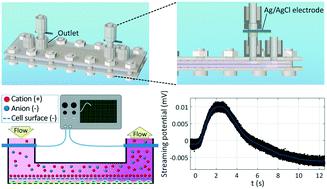Our official English website, www.x-mol.net, welcomes your
feedback! (Note: you will need to create a separate account there.)
A chip device to determine surface charge properties of confluent cell monolayers by measuring streaming potential.
Lab on a Chip ( IF 6.1 ) Pub Date : 2020-09-07 , DOI: 10.1039/d0lc00558d András Kincses 1 , Ana R Santa-Maria , Fruzsina R Walter , László Dér , Nóra Horányi , Dóra V Lipka , Sándor Valkai , Mária A Deli , András Dér
Lab on a Chip ( IF 6.1 ) Pub Date : 2020-09-07 , DOI: 10.1039/d0lc00558d András Kincses 1 , Ana R Santa-Maria , Fruzsina R Walter , László Dér , Nóra Horányi , Dóra V Lipka , Sándor Valkai , Mária A Deli , András Dér
Affiliation

|
Cell surface charge is an important element of the function of biological barriers, but no chip device has been described to measure cell surface charge properties of confluent barrier cell monolayers. The aim of this study was the design and fabrication of a dynamic lab-on-a-chip (LOC) device which is suitable to monitor transcellular electrical resistance, as well as streaming potential parallel to the surface of cell layers. We successfully measured the streaming potential of a biological barrier culture model with the help of our previously published versatile lab-on-a-chip device equipped with two Ag/AgCl electrodes. The inclusion of these “zeta electrodes”, a voltage preamplifier and an oscilloscope in our set-up made it possible to successfully record signals describing the surface charge properties of brain endothelial cell monolayers, used as a barrier model in our experiments. Data obtained on the new chip device were verified by comparing streaming potential results measured in the LOC device and zeta potential results by the commonly used laser-Doppler velocimetry (LDv) method and model simulations. Changes in the negative surface charge of the barrier model by treatments with neuraminidase enzyme modifying the cell membrane glycocalyx or lidocaine altering the lipid membrane charge could be measured by both the upgraded LOC device and LDv. The new chip device can help to gain meaningful new information on how surface charge is linked to barrier function in both physiological and pathological conditions.
中文翻译:

一种通过测量流电势来确定融合细胞单层表面电荷特性的芯片设备。
细胞表面电荷是生物屏障功能的重要元素,但尚未描述用于测量融合屏障细胞单层细胞表面电荷性质的芯片设备。这项研究的目的是设计和制造一种动态芯片实验室(LOC)设备,该设备适用于监测跨细胞电阻以及平行于细胞层表面的流动电位。我们借助先前发布的配有两个Ag / AgCl电极的多功能芯片实验室设备成功地测量了生物屏障培养模型的流动潜力。在我们的装置中加入了这些“ zeta电极”,电压前置放大器和示波器,从而可以成功记录描述脑内皮细胞单层表面电荷特性的信号,在我们的实验中用作障碍模型。通过比较在LOC器件中测量的流电势结果和通过常用激光多普勒测速(LDv)方法和模型仿真得到的zeta电势结果,可以验证在新芯片设备上获得的数据。通过升级的LOC装置和LDv均可测量神经氨酸酶修饰细胞膜糖萼或利多卡因改变脂质膜电荷对屏障模型负表面电荷的变化。新的芯片设备可以帮助获得有意义的新信息,这些信息涉及在生理和病理条件下表面电荷如何与屏障功能相关联。通过比较在LOC器件中测量的流电势结果和通过常用激光多普勒测速(LDv)方法和模型仿真得到的zeta电势结果,可以验证在新芯片设备上获得的数据。通过升级的LOC装置和LDv均可测量神经氨酸酶修饰细胞膜糖萼或利多卡因改变脂质膜电荷对屏障模型负表面电荷的变化。新的芯片设备可以帮助获得有意义的新信息,这些信息涉及在生理和病理条件下表面电荷如何与屏障功能相关联。通过比较在LOC器件中测量的流电势结果和通过常用激光多普勒测速(LDv)方法和模型仿真得到的zeta电势结果,可以验证在新芯片设备上获得的数据。通过升级的LOC装置和LDv均可测量神经氨酸酶修饰细胞膜糖萼或利多卡因改变脂质膜电荷对屏障模型负表面电荷的变化。新的芯片设备可以帮助获得有意义的新信息,这些信息涉及在生理和病理条件下表面电荷如何与屏障功能相关联。通过升级的LOC装置和LDv均可测量神经氨酸酶修饰细胞膜糖萼或利多卡因改变脂质膜电荷对屏障模型负表面电荷的变化。新的芯片设备可以帮助获得有意义的新信息,这些信息涉及在生理和病理条件下表面电荷如何与屏障功能相关联。通过升级的LOC装置和LDv均可测量神经氨酸酶修饰细胞膜糖萼或利多卡因改变脂质膜电荷对屏障模型负表面电荷的变化。新的芯片设备可以帮助获得有意义的新信息,这些信息涉及在生理和病理条件下表面电荷如何与屏障功能相关联。
更新日期:2020-10-13
中文翻译:

一种通过测量流电势来确定融合细胞单层表面电荷特性的芯片设备。
细胞表面电荷是生物屏障功能的重要元素,但尚未描述用于测量融合屏障细胞单层细胞表面电荷性质的芯片设备。这项研究的目的是设计和制造一种动态芯片实验室(LOC)设备,该设备适用于监测跨细胞电阻以及平行于细胞层表面的流动电位。我们借助先前发布的配有两个Ag / AgCl电极的多功能芯片实验室设备成功地测量了生物屏障培养模型的流动潜力。在我们的装置中加入了这些“ zeta电极”,电压前置放大器和示波器,从而可以成功记录描述脑内皮细胞单层表面电荷特性的信号,在我们的实验中用作障碍模型。通过比较在LOC器件中测量的流电势结果和通过常用激光多普勒测速(LDv)方法和模型仿真得到的zeta电势结果,可以验证在新芯片设备上获得的数据。通过升级的LOC装置和LDv均可测量神经氨酸酶修饰细胞膜糖萼或利多卡因改变脂质膜电荷对屏障模型负表面电荷的变化。新的芯片设备可以帮助获得有意义的新信息,这些信息涉及在生理和病理条件下表面电荷如何与屏障功能相关联。通过比较在LOC器件中测量的流电势结果和通过常用激光多普勒测速(LDv)方法和模型仿真得到的zeta电势结果,可以验证在新芯片设备上获得的数据。通过升级的LOC装置和LDv均可测量神经氨酸酶修饰细胞膜糖萼或利多卡因改变脂质膜电荷对屏障模型负表面电荷的变化。新的芯片设备可以帮助获得有意义的新信息,这些信息涉及在生理和病理条件下表面电荷如何与屏障功能相关联。通过比较在LOC器件中测量的流电势结果和通过常用激光多普勒测速(LDv)方法和模型仿真得到的zeta电势结果,可以验证在新芯片设备上获得的数据。通过升级的LOC装置和LDv均可测量神经氨酸酶修饰细胞膜糖萼或利多卡因改变脂质膜电荷对屏障模型负表面电荷的变化。新的芯片设备可以帮助获得有意义的新信息,这些信息涉及在生理和病理条件下表面电荷如何与屏障功能相关联。通过升级的LOC装置和LDv均可测量神经氨酸酶修饰细胞膜糖萼或利多卡因改变脂质膜电荷对屏障模型负表面电荷的变化。新的芯片设备可以帮助获得有意义的新信息,这些信息涉及在生理和病理条件下表面电荷如何与屏障功能相关联。通过升级的LOC装置和LDv均可测量神经氨酸酶修饰细胞膜糖萼或利多卡因改变脂质膜电荷对屏障模型负表面电荷的变化。新的芯片设备可以帮助获得有意义的新信息,这些信息涉及在生理和病理条件下表面电荷如何与屏障功能相关联。











































 京公网安备 11010802027423号
京公网安备 11010802027423号